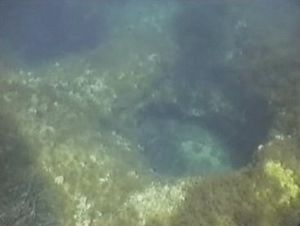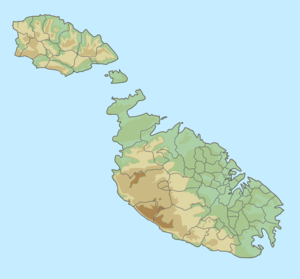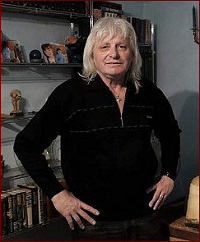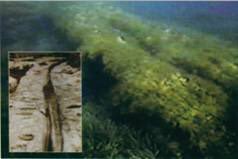Ġebel ġol-Baħar: Difference between revisions
No edit summary |
No edit summary |
||
| Line 15: | Line 15: | ||
https://gozo.news/43478/public-lecture-maltas-underwater-landscapes-by-dr-aaron-micallef/, accessed December 4, 2019.</ref> that before the melting of the glaciers at the end of the ice age, Malta was part of a larger, now submerged tract of land that was "either a large island or islands, or else formed part of Europe or Africa, if not both."<ref name= "godwin">Godwin, George N. | https://gozo.news/43478/public-lecture-maltas-underwater-landscapes-by-dr-aaron-micallef/, accessed December 4, 2019.</ref> that before the melting of the glaciers at the end of the ice age, Malta was part of a larger, now submerged tract of land that was "either a large island or islands, or else formed part of Europe or Africa, if not both."<ref name= "godwin">Godwin, George N. | ||
1880 A guide to the Maltese islands. Whittingham and Co., London. | 1880 A guide to the Maltese islands. Whittingham and Co., London. | ||
</ref> In 1854, Maltese architect and antiquarian Giorgio Grongnet de Vasse first proposed that the Maltese Islands composed part of the lost continent of Atlantis, citing the platonic dialogues as proof, as Plato | </ref> In 1854, Maltese architect and antiquarian Giorgio Grongnet de Vasse first proposed that the Maltese Islands composed part of the lost continent of Atlantis, citing the platonic dialogues as proof, as Plato described Atlantis being "pro" or in front of the [https://en.wikipedia.org/wiki/Pillars_of_Hercules Pillars of Heracles], which he proposed meant an area proximate to the strait of Sicily, or in this case, Malta.<ref name= "giorgio">Schiavone, Michael J. 2009 Dictionary of Maltese Biographies. Pietà: Pubblikazzjonijiet Indipendenza, 2:989–990.</ref> Following de Vasse, Maltese botonist John Borg stated that Atlantis was situated between Malta and North Africa, and R. M. Gattefosse commented that he believed that Malta's legitimate archaeological sites bore an "Atlantean" Character.<ref name="atlantipedia">Atlantipedia | ||
n.d. Hubert Zeitlmair. Electronic document, http://atlantipedia.ie/samples/tag/hubert-zeitlmair/, accessed | n.d. Hubert Zeitlmair. Electronic document, http://atlantipedia.ie/samples/tag/hubert-zeitlmair/, accessed | ||
December 4, 2019. | December 4, 2019. | ||
</ref> | </ref> Importantly, much of the focus on Malta as a home for Atlantis occurred during and right after the period of time Malta existed as a British Protectorate and was denied home rule by the British Empire, one of the reasons George Godwin had such good access to Malta in the first place.<ref name= "nationalism">Mitchell, Jon P. | ||
2010 Looking Forward to the Past: National Identity and History in Malta. | |||
Identities: Global Studies in Culture and Power 10:3, 377-398</ref> Although the British occupation of Malta was far from the scale or impact of other British colonial pursuits, it did have a significant impact on the development of Maltese political parties and national identity.<ref name= "nationalism" /> Because the burgeoning far-right nationalist movement in Malta had a vested interest in ousting the British, when Malta was allowed to form political parties, the nationalist party, which was headed by Malta's upper classes, allied itself with Italy (the previous occupying force before the British) and the Liberal-Democratic party, who favored the British democratic reforms, allied themselves with England.<ref name= "nationalism" /> As a result, a lot of early Atlantis narratives in Malta by indigenous Maltese people incorporate an element of nationalist pseudoarchaeology. Not only did the postulate that Malta was related to Atlantis bolster national pride and identity, but pseudoarchaeology that specifically tied Malta to Sicily via landbridge, reifying the claims and prerogatives of the Nationalist party. | |||
After the 1956 referendum to incorporate Malta into the UK failed however, and colonial rule became less of an issue, nationalist fueled narratives of Italy-Malta as the site of Atlantis fell out of favor. It wasn't until 2001, when pseudoarchaeologist Anton Misfud revived the idea in his book "Echoes of Plato's Island," that the idea of Malta as the ancient location for Atlantis resurfaced.<ref name= "misfud">Misfud, Anton, Chris A Sultana, Simon Misfud and Charles S Ventura | |||
2000 MALTA - ECHOES OF PLATO'S ISLAND. Prehistoric Society of Malta, Mosta. | 2000 MALTA - ECHOES OF PLATO'S ISLAND. Prehistoric Society of Malta, Mosta. | ||
</ref> Misfud, building off of the ideas of Gowin, de Vasse, Borg and Gattefosse, supported his belief with a typological comparison of some of the skulls found in Maltese prehistoric temples and skulls from pre-dynastic egypt.<ref name="misfud"/> Additionally, he claims that the high volume of megalithic temples on Malta, as well as the deep, abruptly ending tracts still present on the islands, is evidence that Malta was once home to an advanced, Atlantean civilization.<ref name="atlantipedia" /> | </ref> Misfud, building off of the ideas of Gowin, de Vasse, Borg and Gattefosse, supported his belief with a typological comparison of some of the skulls found in Maltese prehistoric temples and skulls from pre-dynastic egypt.<ref name="misfud"/> Additionally, he claims that the high volume of megalithic temples on Malta, as well as the deep, abruptly ending tracts still present on the islands, is evidence that Malta was once home to an advanced, Atlantean civilization.<ref name="atlantipedia" /> | ||
Revision as of 06:03, 6 December 2019
by Ayla Schwartz
Ġebel ġol-Baħar is an alleged underwater megalithic site in Malta located off the coast of St. George's Bay. [1] It was discovered by pseudoarchaeologist and unaccredited academic Hubert Zeitlmair on April 13th, 1999 and announced at a "Paleo-Astronauts" conference later that same year. [2]

What is Ġebel ġol-Baħar?
Malta and Pseudoarchaeology

Malta has long been the focus of pseudoarchaeologists and Atlantean conspiracy theorists for the incredible breadth of its archaeological history as well as its location as an island in the western hemisphere, which unfortunately fits the bill for a potential site for the mythical Atlantis as described in the Platonic dialogues. Pseudoarchaeogy's interest in Malta began with a guide to Malta written by British army chaplain Rev. George Nelson Godwin. In this guide, Godwin noted the legitimate scientific fact[5] that before the melting of the glaciers at the end of the ice age, Malta was part of a larger, now submerged tract of land that was "either a large island or islands, or else formed part of Europe or Africa, if not both."[6] In 1854, Maltese architect and antiquarian Giorgio Grongnet de Vasse first proposed that the Maltese Islands composed part of the lost continent of Atlantis, citing the platonic dialogues as proof, as Plato described Atlantis being "pro" or in front of the Pillars of Heracles, which he proposed meant an area proximate to the strait of Sicily, or in this case, Malta.[7] Following de Vasse, Maltese botonist John Borg stated that Atlantis was situated between Malta and North Africa, and R. M. Gattefosse commented that he believed that Malta's legitimate archaeological sites bore an "Atlantean" Character.[8] Importantly, much of the focus on Malta as a home for Atlantis occurred during and right after the period of time Malta existed as a British Protectorate and was denied home rule by the British Empire, one of the reasons George Godwin had such good access to Malta in the first place.[9] Although the British occupation of Malta was far from the scale or impact of other British colonial pursuits, it did have a significant impact on the development of Maltese political parties and national identity.[9] Because the burgeoning far-right nationalist movement in Malta had a vested interest in ousting the British, when Malta was allowed to form political parties, the nationalist party, which was headed by Malta's upper classes, allied itself with Italy (the previous occupying force before the British) and the Liberal-Democratic party, who favored the British democratic reforms, allied themselves with England.[9] As a result, a lot of early Atlantis narratives in Malta by indigenous Maltese people incorporate an element of nationalist pseudoarchaeology. Not only did the postulate that Malta was related to Atlantis bolster national pride and identity, but pseudoarchaeology that specifically tied Malta to Sicily via landbridge, reifying the claims and prerogatives of the Nationalist party.
After the 1956 referendum to incorporate Malta into the UK failed however, and colonial rule became less of an issue, nationalist fueled narratives of Italy-Malta as the site of Atlantis fell out of favor. It wasn't until 2001, when pseudoarchaeologist Anton Misfud revived the idea in his book "Echoes of Plato's Island," that the idea of Malta as the ancient location for Atlantis resurfaced.[10] Misfud, building off of the ideas of Gowin, de Vasse, Borg and Gattefosse, supported his belief with a typological comparison of some of the skulls found in Maltese prehistoric temples and skulls from pre-dynastic egypt.[10] Additionally, he claims that the high volume of megalithic temples on Malta, as well as the deep, abruptly ending tracts still present on the islands, is evidence that Malta was once home to an advanced, Atlantean civilization.[8]
Hubert Zeitlmair

Hubert Zeitlmair is by far the most involved player in the Gebel gol-Bahar narrative. Born on May 22nd 1954 in Augsburg, Germany, Zeitlmair is a former real estate investor who now works as an educator and self-proclaimed professor at the University of Quantum Dynamics, a non-for-profit organization that operates largely through in-person workshops and one on one skype tutoring[11]. Zeitlmair first ventured into pseudoarchaeology while attempting to "search for the primeval roots of [his] ancestors and humanity,"[12] though no explanation as to what that means or entailed has ever been documented. During this period, Zeitlmair became increasingly more interested in European pre-history and became acquainted with the works of Zecharia Sitchin.[12] He believes that Malta is the original home of Atlantis and subscribes to Sitchin's postulates about the visitation of Earth by the Nibiru of Planet X, attributing this contact to the Atlanteans advanced knowledge.[2]
In 1999, Zeitlmair sponsored a dive in the area off the coast of the Maltese town of St. Julian's to look for submerged temples.[8] On July 13th of that year, Shaun and Kurt Arrigo purportedly discovered an underwater megalithic site that became the basis of Zeitlmair's career, which he named Gebel gol-Bahar - Maltese for "Stones in the Sea."[13] Zeitlmair reported this find at the 1999 Paleo-Astronauts conference and returned to Malta later that year as well as in 2000 to further "study" the Gebel gol-Bahar site and take detailed measurements of an area he claimed to be a megalithic temple.[2]
Currently, Zeitlmair offers several workshops and "classes" on the topic of Atlantis, Malta, and Gebel gol-Bahar, as well as several other new-age courses related to overcoming transcience, natural energies, and ancient astronauts.[11]
Ġebel ġol-Baħar and Pseudoarchaeological Narrative
Hubert Zeitlmair's "Theories"
It is important to consider that Zeitlmair's theories, questions, and beliefs came to be within the context of other pseudoarchaeological discourse. Zeitlmair's interest in archaeology began and ended with the likes of Zecharia Sitchin, Erich von Daniken, and Anton Misfud. Zeitlmair's ideas are not as novel or revolutionary as he might claim. Instead, they are well understood, repetitious ideas within the archaeological community, common and predictable within the context. His 'theories,' if they can be called that, build on and are influenced by the ideas of other people before him, and are influenced by the culture and atmosphere of pseudoarchaeology when he entered the field.
That being said, Hubert Zeitlmair's theories are a particular blend of pseudoarchaeological and pseudoscientific beliefs that are interesting to explore. Ġebel ġol-Baħar occupies an intersection of common pseudoarchaeological themes: the Atlantis narrative, the ancient astronaut's hypothesis, biblical pseudoarchaeology, and hyperdiffusionism.
Atlantis Narrative
The strongest narrative thread in Zeitlmair's Ġebel ġol-Baħar work is the that Ġebel ġol-Baħar, and indeed, all of Malta and the associated sea floor, is the site of the lost civilization of Atlantis.[12]
Atlantis and Hyperdiffusionism
Ancient Astronauts
Genesis Flood Story
==

The Archaeological Response
Malta's temples and archaeological record
The Evidence (or lack thereof) for Atlantis
References
- ↑ Malta Dives N.d. Gebel gol-Bahar. Electronic document, https://maltadives.com/sites/gebelgolbahar/en, accessed November 4, 2019
- ↑ 2.0 2.1 2.2 Rose, Mark 2013 Archaeological Institute of America. Electronic document, https://archive.archaeology.org/online/news/aliens.html, accessed November 4, 2019.
- ↑ Electric Universe forum - Everything Is Electric 2009 Topic: Gebel Gol-Bahar - an underwater Temple off the coast of Malta. Electronic document, http://www.everythingselectric.com/forum/index.php?topic=190.0, accessed December 4, 2019.
- ↑ Wikimedia Commons n.d. Malta relief location. Electronic Document, https://commons.wikimedia.org/wiki/File:Malta_relief_location_map.png, accessed December 4, 2019
- ↑ Micallef, Aaron 2014 Public Lecture – Malta’s Underwater Landscapes by Dr. Aaron Micallef. Electronic document, https://gozo.news/43478/public-lecture-maltas-underwater-landscapes-by-dr-aaron-micallef/, accessed December 4, 2019.
- ↑ Godwin, George N. 1880 A guide to the Maltese islands. Whittingham and Co., London.
- ↑ Schiavone, Michael J. 2009 Dictionary of Maltese Biographies. Pietà: Pubblikazzjonijiet Indipendenza, 2:989–990.
- ↑ 8.0 8.1 8.2 Atlantipedia n.d. Hubert Zeitlmair. Electronic document, http://atlantipedia.ie/samples/tag/hubert-zeitlmair/, accessed December 4, 2019.
- ↑ 9.0 9.1 9.2 Mitchell, Jon P. 2010 Looking Forward to the Past: National Identity and History in Malta. Identities: Global Studies in Culture and Power 10:3, 377-398
- ↑ 10.0 10.1 Misfud, Anton, Chris A Sultana, Simon Misfud and Charles S Ventura 2000 MALTA - ECHOES OF PLATO'S ISLAND. Prehistoric Society of Malta, Mosta.
- ↑ 11.0 11.1 11.2 Sovereign White Knights n.d. I AM...Hubert Zeitlmair. Electronic document, http://www.sovereignwhiteknights.eu/I-AM-HubertZeitlmair.html, accessed December 4, 2019.
- ↑ 12.0 12.1 12.2 ATLANTIS HERITAGE n.d. ATLANTIS HERITAGE ATLANTIS INHERITANCE. Electronic document, http://atlantis-erbe.eu/#uwr_02,07_Under_water_research/02.htm, accessed December 4, 2019.
- ↑ Hubert Zeitlmair 2014 Maltadiscovery presents Remains of Atlantis in Malta! Underwater Tempel found!. Electronic document, https://www.youtube.com/watch?v=NPnRUI_y-Ek, accessed December 4, 2019.
- ↑ Zeitlmair, Hubert 2016 PNG file. Electronic document, https://twitter.com/maltadiscovery/status/701420164743622657, accessed December 4, 2019